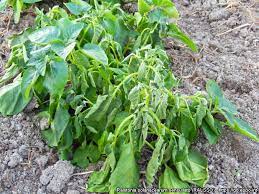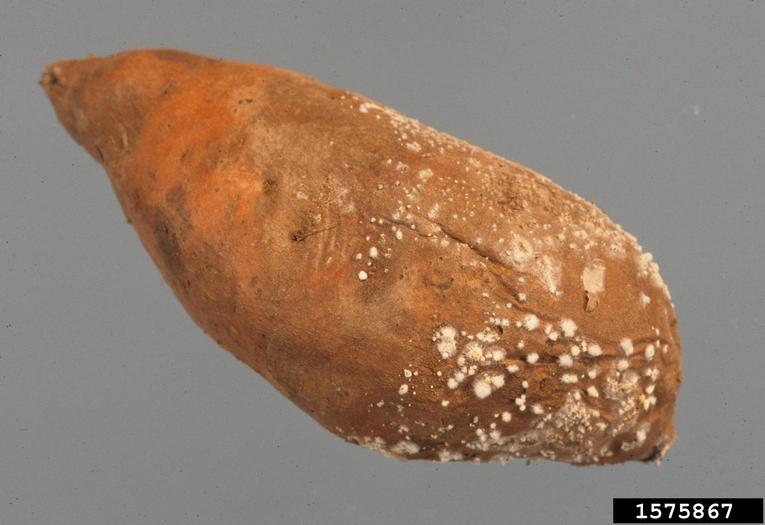
Vegetable
Ipomoea batatas
Food Crop Diseases
Soft rot disease
| Symptoms |
|---|
| Streptomyces ipomoea is a bacterium species from the genus of Streptomyces. It has been isolated from rot from potatoes. This bacterium produces thaxtomin C and ipomycin. It can cause soft rot disease on sweet potatoes. The disease is characterized by misshapen storage roots with rough, scabby pits or shallow surface lesions that result in scars. Fibrous roots develop dark, necrotic lesions that eventually kill the root. |
| Effect on Crops |
|---|
| Preventative Strategies |
|---|
Unknown
| Symptoms |
|---|
| Effect on Crops |
|---|
| Preventative Strategies |
|---|
Potato bacterial wilt
| Symptoms |
|---|
| New sprouts wilting and have water-soaked bases which turn yellow-brown to dark brown in color; vascular system of the sprouts is discolored brown; infection of healthy transplants causes the lower portions of the stems to become water-soaked and turn a similar color to infected sprouts; yellow-brown streaks may develop inside storage roots and, if infection is severe, gray-brown water-soaked lesions may be present on the root surface. |

| Effect on Crops |
|---|
| Preventative Strategies |
|---|
Fusarium root and stem rot
| Symptoms |
|---|
| Fusarium root and stem rot is a disease caused by the fungus Fusarium solani f. sp. cucurbitae. It primarily affects cucurbits such as cucumbers, melons, and squash. The symptoms of this disease include necrotic lesions on the stem near the ground, which can eventually girdle the stem. Infected plants become wilted and die rapidly during mid-season. The decay at the base of the stem is soft and mushy. Fruit lesions begin as small corky cracks that develop into sunken necrotic lesions. The internal tissue near the site of infection becomes off-color and corky, resulting in a firm, dry rot. To control Fusarium root and stem rot, it is recommended to use crop rotations and clean seed. Please note that this disease primarily affects cucurbits and may not be directly related to sweet potatoes. If you have any specific questions about sweet potato diseases, contact local Extension officer or officer. |

| Effect on Crops |
|---|
| Preventative Strategies |
|---|
Unknown
| Symptoms |
|---|
| Unknown |
| Effect on Crops |
|---|
| Preventative Strategies |
|---|
Bacterial soft rot
| Symptoms |
|---|
| Sweet potatoes are susceptible to bacterial soft rot caused by Erwinia chrysanthemi. The bacterium can infect both the tuber and root system of sweet potatoes, leading to rotting. The infection is more common during storage, but it can also occur while the sweet potatoes are growing in the garden. Symptoms of bacterial soft rot include black, necrotic, water-soaked lesions on the foliage and dark brown to black lesions on the stems. In the root system, infected sweet potatoes become light brown in color and watery, with lesions having a characteristic dark brown margin. Some roots may appear unaffected until they are cut into, revealing decay. |
| Effect on Crops |
|---|
| The effect of bacterial soft rot caused by Erwinia chrysanthemi on yield can vary depending on the host plant and other factors. While I couldn’t find specific information about the effect of this bacterium on sweet potato yield, I found a study that reported severe yield losses in myoga (Zingiber mioga) due to bacterial soft rot caused by Erwinia chrysanthemi. In some greenhouses, over 30% of harvested flower buds were rotten, leading to severe yield losses. It’s important to note that bacterial soft rot can cause the decay and rotting of infected plant tissues, which can result in reduced yield and quality of the affected crop. The severity of the impact may depend on factors such as the susceptibility of the host plant, environmental conditions, cultural practices, and disease management strategies. To minimize the impact of bacterial soft rot on yield, it is crucial to implement proper disease management practices. These may include minimizing wounding of plant tissues, handling plants carefully during harvesting and storage, controlling insects that may cause wounding, using disease-free propagating materials, selecting cultivars with tolerance to the disease, and promptly removing and destroying any infected plant parts. |
| Preventative Strategies |
|---|
| The effect of bacterial soft rot caused by Erwinia chrysanthemi on yield can vary depending on the host plant and other factors. While I couldn’t find specific information about the effect of this bacterium on sweet potato yield, I found a study that reported severe yield losses in myoga (Zingiber mioga) due to bacterial soft rot caused by Erwinia chrysanthemi. In some greenhouses, over 30% of harvested flower buds were rotten, leading to severe yield losses. It’s important to note that bacterial soft rot can cause the decay and rotting of infected plant tissues, which can result in reduced yield and quality of the affected crop. The severity of the impact may depend on factors such as the susceptibility of the host plant, environmental conditions, cultural practices, and disease management strategies. To minimize the impact of bacterial soft rot on yield, it is crucial to implement proper disease management practices. These may include minimizing wounding of plant tissues, handling plants carefully during harvesting and storage, controlling insects that may cause wounding, using disease-free propagating materials, selecting cultivars with tolerance to the disease, and promptly removing and destroying any infected plant parts. |